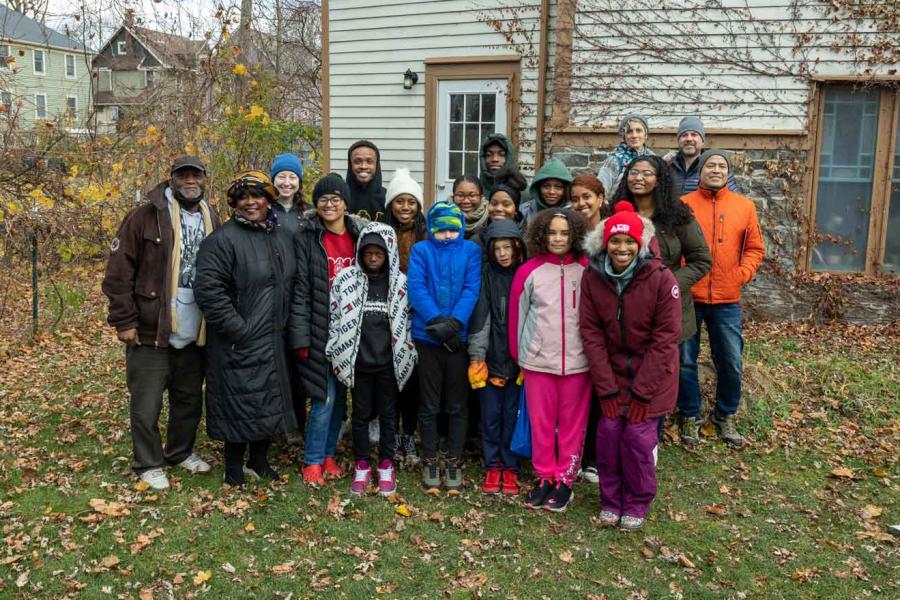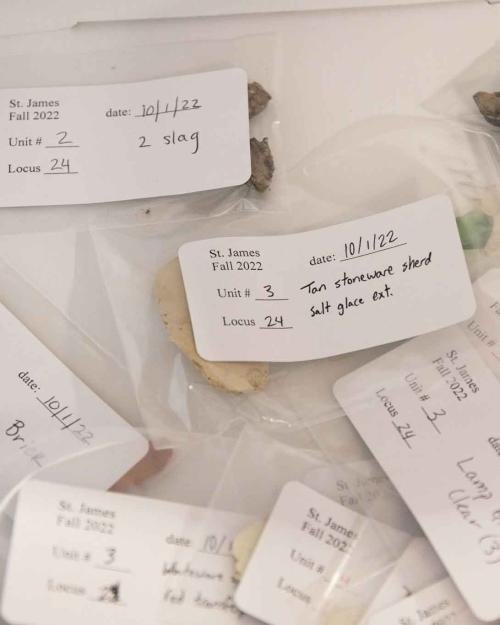Close
Cornell faculty and students continued to work this semester with community members on an archaeological excavation project at St. James A.M.E. Zion Church in downtown Ithaca.
Uncovering more than 2,000 additional artifacts, this semester’s work also featured an end-of-semester mini-field course for local children and youth presented by Cornell students Aaliyah Brown ’23 and Milan Taylor ’24. The two undergraduates were part of the first for-credit class focused on the project, “Field Methods in Community-Engaged Archaeology.”
“Aaliyah and Milan had the inspired idea for this event, which was a beautiful way to wrap up this season’s excavations,” said Samantha Sanft Ph.D. ’21, a postdoctoral associate with the Cornell Institute of Archaeology and Material Studies (CIAMS) who taught the Field Methods class. Brown and Taylor wanted to take what they’ve learned this semester in the Field Methods course and put it into practice through this program.
“It’s an event we hope to replicate next fall as well,” Sanft said. “This is an ongoing project that keeps evolving, providing the opportunity for Cornell students, as well as middle and high school students, to learn more about the rich history of St. James A.M.E. Zion Church, through archaeology.”
Beginning in 2021, CIAMS faculty members Adam T. Smith, Distinguished Professor of Arts and Sciences in Anthropology (A&S) and Lori Khatchadourian, associate professor of Near Eastern studies (A&S), began working on the project with Gerard Aching, W. E. B. DuBois Professor in the Humanities in the Africana Studies and Research Center and in the Department of Romance Studies (A&S) and Reverend Terrance King of St. James A.M.E. Zion Church. The project explores the history of the St. James community and is part of a larger Underground Railroad Research Project, spearheaded by Aching.

This semester’s community sessions were held on Saturdays and coordinated with the Science and Mathematics Saturday Academy, an extracurricular STEM program for youth founded and organized by Ithaca teachers Denise Lee ’73 and Abe Lee ’73. Youth involved in the program received a field kit containing a brush, a trowel, artifact bags, a compass and other tools necessary for archaeological research.
Many other students and faculty have also been intricately involved with the project. Lillie Steen ’23 is working on a senior thesis on the food history of the church, based on animal remains and archival research. She’s under the supervision of Nerissa Russell, professor and chair of the anthropology department.
“A recent trip to the Paleontological Research Institute for a consultation with shell expert Dr. Gregory Dietl established that shells of hard-shell clams occur across the site, raising the possibility of clambakes,” Russell said. “Finds of pig teeth are also intriguing, since they would not come from a supermarket cut and might imply pig roasts.”

During the Nov. 19 mini-course, Brown and Taylor discussed some of the history of St. James, the process of an archaeological project, the tools needed for this work and the methods of carefully removing layers of soil to uncover and then identify and preserve potential artifacts.
“Archaeology is a highly-exclusive field with a racist foundation,” Brown said. “St. James AME Zion Church, furthermore, has rich roots in the Underground Railroad and the founding of Black Greek Life. It was important for Milan and myself to engage black youth in this archaeological project to bring community engagement in the context of unearthing Black history in Ithaca to the forefront of the conversation.”
Temperatures that day were freezing, so the students didn’t actually dig in the soil, but every other Saturday, community members were involved in digging. During lunch, the students spoke about how they became interested in archaeology and what careers are available in the field.
“Community archaeology is important because it exposes students, like those who attended our event, to the field,” Taylor said. “Archaeology isn’t necessarily the first career that kids think about when they’re growing up, so integrating archaeologists into the community also exposes students to a world of scientific possibilities.”
During the spring semester, Sanft said CIAMS faculty and staff will be examining the artifacts found this semester, as well as planning for the 2023 fall project and class.
Copyrights © 2023 stjamesithaca.com